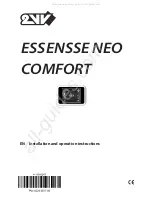
CNT-SVX04A-EN
Binary inputs
28
Occupancy
The Tracer ZN.520 zone controller uses the occupancy binary input for two
occupancy-related functions. For stand-alone controllers (any unit not receiving
a communicated occupancy request, typically from a building automation
system such as Tracer Summit), the occupancy binary input determines the
unit's occupancy based on the hardwired signal. Normally, the signal is
hardwired to a binary switch or clock.
When a hardwired occupancy signal is open, the unit switches to occupied
mode (if the occupancy input is configured as normally open). When a
hardwired occupancy signal is closed, the controller switches to unoccupied
mode.
For controllers that receive a communicated occupancy request (typically from
a building automation system such as Tracer Summit), the hardwired
occupancy binary input, along with the communicated occupancy request,
places the controller in either occupied mode or occupied standby mode.
In occupied mode, the controller operates according to the occupied setpoints.
In occupied standby mode, the zone controller operates according to the
occupied standby setpoints. When the controller receives a communicated
unoccupied request, the controller operates according to the unoccupied
setpoints regardless of the state of the hardwired occupancy input.
When neither the binary input nor the communicated input is used to select the
occupancy mode, the controller defaults to occupied mode because the
occupancy binary input (if present) typically is configured as normally open and
no occupancy device is connected.
Tables 24 and 25 describe the combination of communication requests and the
hardwired input upon the occupancy state of the control.
















































